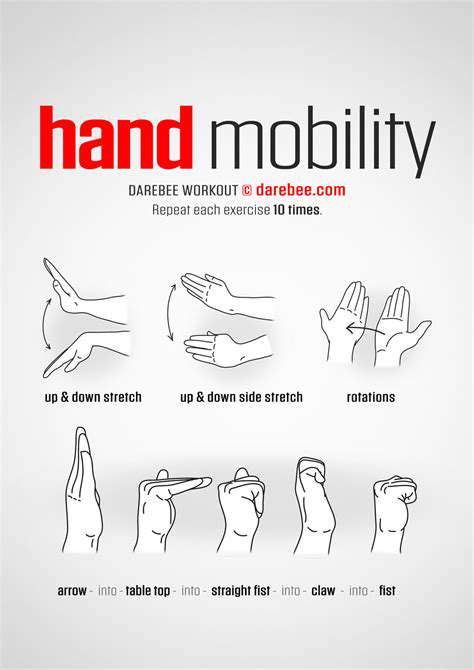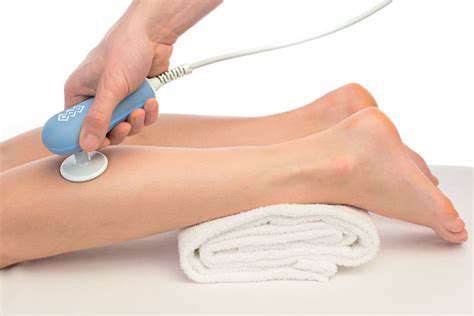Tennis Elbow: Causes and Treatments
Repetitive Strain
Tennis elbow, also known as lateral epicondylitis, is frequently linked to repetitive strain on the tendons that connect the forearm muscles to the bony prominence on the outside of the elbow. This repetitive action, often involving gripping, twisting, or extending the wrist, can gradually inflame and irritate these tendons. Activities like painting, using tools, playing certain sports, and even prolonged computer use can contribute to this overuse. Understanding the specific movements and forces involved in your daily or recreational activities is crucial for identifying potential risk factors.
Understanding the mechanics of the repetitive motions is key to preventing further strain. For instance, if you work in a job requiring frequent gripping, implementing ergonomic adjustments, such as using tools with better handles or taking breaks to rest your forearm muscles, can significantly reduce the risk of developing tennis elbow.
Incorrect Technique
Using improper technique during activities that involve repetitive wrist movements can also strain the tendons in the elbow. This includes using incorrect grip strength, awkward posture while playing sports, or even using improper form while performing tasks like hammering or painting. Many sports, such as tennis, golf, and even some types of weightlifting, involve specific techniques that, when not followed correctly, can place undue stress on the elbow.
Analyzing your technique in activities that strain your wrist can help you identify potential sources of the problem. Seeking advice from a physical therapist or coach experienced in the specific activity can provide valuable insights into how to modify your technique to minimize strain on the elbow and improve performance.
Age and Anatomy
Age can play a role in the development of tennis elbow. As we age, our tendons can naturally lose some of their elasticity and become more susceptible to injury. This is not to say that young people are immune, but the risk is heightened with age. Moreover, certain anatomical variations can also increase the likelihood of developing tennis elbow. For example, individuals with a naturally weaker or less supportive forearm structure may be more predisposed to the condition.
Understanding how your individual anatomy might contribute is essential to a preventative approach. Consult with a doctor or physical therapist to explore potential underlying anatomical factors that might increase your risk. Early intervention and appropriate treatment plans can significantly reduce long-term complications.
Underlying Medical Conditions
While less common, certain underlying medical conditions can sometimes contribute to the development of tennis elbow. These conditions can include rheumatoid arthritis, gout, or other inflammatory conditions that affect the tendons and surrounding tissues. It is crucial to consider the possibility of an underlying medical condition if the elbow pain persists despite other treatments. A comprehensive evaluation by a healthcare professional can help identify any potential underlying conditions.
If pain persists despite rest, ice, and over-the-counter pain relievers, it's vital to seek professional medical advice. A medical evaluation can rule out any underlying medical issues and ensure that appropriate treatment strategies are implemented to address the root cause of the pain.
Proper lighting is crucial for indoor plants, mimicking the sunlight they need to thrive. Different plants have different light requirements, so understanding these needs is key. For example, leafy greens and herbs often require more intense light than succulents or orchids. Investing in adjustable grow lights that can be positioned and adjusted to suit specific plant types is a smart investment. These lights often come in various strengths and spectra, allowing you to tailor the light intensity and color to best support your plants' growth and development. Consider the size of your indoor space and the types of plants you plan to grow when choosing the appropriate lighting solution.
Effective Treatment Options: Beyond Rest

Pharmacological Interventions
Medication plays a crucial role in managing many conditions, and effective treatment options often involve a combination of pharmacological interventions. These treatments can range from simple over-the-counter remedies to complex, prescription-based medications. Understanding the specific needs of each individual is paramount, and personalized approaches are often necessary for optimal results. This may involve adjusting dosages or switching medications based on individual responses and potential side effects.
Different medications work in various ways, targeting specific pathways and mechanisms within the body. Careful consideration of potential interactions between different medications is essential, and regular monitoring by healthcare professionals is critical to ensure safety and efficacy.
Lifestyle Modifications
Adopting healthier lifestyle choices can significantly improve overall well-being and contribute to the effectiveness of other treatment options. This includes dietary adjustments, regular exercise, stress management techniques, and sufficient sleep. These modifications can address underlying factors that contribute to the condition, leading to substantial improvements in symptoms and overall health.
A balanced diet rich in fruits, vegetables, and lean proteins, coupled with regular physical activity, can significantly enhance the body's ability to heal and function optimally. Consistent sleep patterns and stress-reduction strategies further support the body's natural healing processes.
Complementary Therapies
Complementary therapies, such as acupuncture, massage therapy, and mindfulness practices, can provide valuable support in conjunction with conventional medical treatments. These techniques can address the physical, emotional, and mental aspects of a condition, fostering a holistic approach to wellness. These methods may offer relief from symptoms and promote overall well-being.
Many individuals find that incorporating these complementary therapies into their treatment plans can improve their overall quality of life. However, it's crucial to discuss any complementary therapies with your healthcare provider to ensure they are safe and compatible with your existing treatments.
Surgical Interventions
Surgical procedures are sometimes necessary to address certain conditions or complications. These interventions can involve various techniques, from minimally invasive procedures to more extensive surgeries, depending on the specific nature of the condition and its impact on the body. Surgical options are generally considered for situations where other treatments have proven ineffective or if the condition poses an immediate threat to health.
Careful evaluation and consideration of the potential risks and benefits are essential before pursuing any surgical intervention. This often involves a discussion with surgical specialists to determine the best course of action for each individual patient.
Psychological Support
Psychological factors can significantly influence the course and severity of various health conditions. Addressing these factors through counseling, therapy, or support groups can be crucial for effective treatment. This can involve helping individuals develop coping mechanisms to manage stress, anxiety, and depression, which can all impact overall health. These strategies are often essential for long-term well-being and can significantly improve treatment outcomes.
Rehabilitative Programs
Rehabilitative programs play a vital role in helping individuals regain or improve their physical and functional abilities after an illness or injury. These programs can include a variety of therapies such as physiotherapy, occupational therapy, and speech therapy. These interventions are designed to help individuals recover lost function and enhance their independence. Rehabilitation programs provide tailored strategies to address specific needs and goals, optimizing recovery and promoting a return to a fulfilling lifestyle.
Preventing Tennis Elbow Recurrence: Lifestyle Adjustments
Understanding the Underlying Causes
Tennis elbow, also known as lateral epicondylitis, is a painful condition affecting the tendons on the outside of the elbow. While repetitive motions are often cited as a primary cause, the truth is more nuanced. Beyond overuse, factors like improper form during activities, pre-existing muscle imbalances, and even certain medical conditions can contribute to the development and recurrence of tennis elbow. Understanding these contributing factors is crucial for preventing future episodes.
Identifying and addressing these underlying causes is a vital first step in preventing recurrence. This involves a thorough assessment of your daily activities, including the way you hold tools, perform tasks around the house, and engage in sports. Consulting with a physical therapist or doctor can help pinpoint any imbalances that might be predisposing you to the condition.
Modifying Repetitive Activities
For many individuals, work or recreational activities are significant contributors to tennis elbow. Simply changing the way you perform repetitive movements can make a world of difference. If your job involves frequent use of tools or equipment, ergonomic adjustments and breaks are essential. Taking frequent short breaks to stretch and rest the affected area can significantly reduce stress on the tendons. This could involve a simple change in posture or grip, or even using specialized tools or equipment.
In recreational activities, paying close attention to form and technique is crucial. Adjusting your swing in tennis, your grip in golf, or your lifting technique in weight training can lessen strain on the elbow. Listening to your body and avoiding pushing through pain are important strategies to prevent further injury and recurrence.
Strengthening Supporting Muscles
The muscles surrounding the elbow joint play a critical role in stabilizing it during various motions. Strengthening these supporting muscles is vital for preventing tennis elbow from returning. This can involve a variety of exercises, including targeted strengthening exercises for the forearm muscles and wrist extensors. A physical therapist can develop a tailored program that addresses specific weaknesses and promotes overall strength and flexibility.
Maintaining Proper Posture and Body Mechanics
Maintaining good posture and body mechanics throughout daily activities is crucial in preventing tennis elbow. Poor posture can lead to muscle imbalances and increased stress on the tendons. Being mindful of your posture while sitting, standing, and lifting objects can help reduce the risk of injuring the elbow.
This involves not only proper posture but also using correct body mechanics when lifting or carrying items. Using your legs to lift rather than your back, and keeping your back straight are important strategies to prevent injuries.
Implementing Regular Stretching and Warm-up Routines
Regular stretching and warm-up routines are essential for preparing your muscles and tendons for activity. Before engaging in any activity that puts stress on the elbow, it's crucial to warm up properly. This helps to increase blood flow to the area, making the tendons and muscles more flexible and less prone to injury. Stretches targeting the forearm, wrist, and elbow should be incorporated into your routine.
Consistency is key to prevent tennis elbow from recurring. By incorporating these stretches into your daily or pre-activity routine, you're actively working to maintain the health and flexibility of the muscles and tendons around your elbow, reducing the risk of future injury.
Read more about Tennis Elbow: Causes and Treatments
Hot Recommendations
- The Impact of the Digital Age on Hand Function
- The Role of Hands in Agricultural Innovation
- The Impact of Technology on Hand Artistry
- The Importance of Hand Care for Artists
- How Hand Control Enhances Robotic Surgery
- The Impact of Hand Strength on Physical Labor
- How Handwriting Influences Cognitive Development
- The Impact of Environmental Factors on Hand Health
- The Power of Hands in Building Community
- The Importance of Ergonomics in Hand Health











